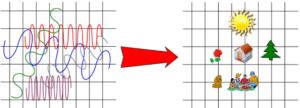In everyday life, we in the Westernized world assume that an objective reality exists external to us. We usually assume that the outside world exists and we are merely observing it. We do not think of ourselves as dreaming the physical universe. It is not “all in our mind.” Philosophers call this assumption “realism.”
Realism vs. Idealism
Realism contrasts with idealism. The philosophical meaning of “idealism” is the assumption that the physical universe arises from consciousness. One branch of idealism, for example, posits a single source of consciousness which is “dreaming” the physical universe. Just as the people and cars and houses in our dreams at night seem real to us, the physical universe seems real to us even though it is being dreamed. This is a key assumption of Buddhism. When we wake up in the morning, we say to ourselves, “Oh, it was just a dream.” When people wake up from the “illusion” of the physical universe, Buddhists say that they have woken up and are now Enlightened.
Idealism is not uniquely an assumption of Buddhism and other Eastern religions. Western philosophers, notably the British philosopher, George Berkeley (1685-1753) and the German philosopher, Immanuel Kant (1724-1804), both espoused versions of idealism.
Today, there is renewed interest in idealism among philosophers and scientists. For example, Donald Hoffman, a cognitive scientist, and Bernardo Kastrup, a philosopher and computer scientist, both have published books and articles espousing versions of idealism. These publications address the key questions raised by idealism:
- How does it happen that we are all having the same “dream”?
- Why is the “dream” so lawful?
- If the physical universe arises from consciousness, why can’t we change what happens in the physical universe by our own volition?
Scientific Realism
However, mainstream science since at least the time of Isaac Newton (1643-1727) and into current times assumes realism. It assumes that a form of physical energy, possibly strings or quantum fields or…, is fundamental and everything else arises from this fundamental physical thing. And regarding consciousness, it’s part of “everything else” that arises from the physical fundamental thing. Usually the assumption is that consciousness arises, in an unknown manner, from the physical brain. This paragraph describes “scientific realism.”
Scientific Realism and Quantum Mechanics
According to the Classical Physics of Isaac Newton, which assumed scientific realism, objects have defined properties independent of our measurements. A chair, for example, sitting in Carnegie Hall, has an exact position. We can accurately describe that position by measuring its distance from the walls and the floor. But we assume that before we measured it, its position was definite and completely defined. The chair’s position is not a range of numbers, each having a certain probability of actualizing at the moment of measurement. No—leave that kind of behavior to quantum mechanics.
In quantum mechanics, scientific realism runs into trouble. If an outside world exists, and we merely perceive it, we should expect that the properties of quantum particles are pre-existing and inherent in the particles. We need only measure (detect) them. However, in quantum mechanics, only upon measurement (detection) do certain properties exist. For example, the position of an electron in a box is in a cloud of quantum possibilities (a “superposition”) until measured. In this cloud of possibilities, the electron has a certain probability of being in any particular position. But the particle assumes no specific position until the moment of measurement. Experiments such as the Double Slit Experiment provide empirical evidence of the lack of realism, in this sense, of atomic and subatomic particles. For more on this topic, see the definition of measurement.

Modification of David Chalmers and Kelvin McQueen, “Consciousness and the Collapse of the Wave Function” http://consc.net/slides/collapse.pdf]
However, most physicists today (2020) make the assumption of scientific realism. Many just don’t think much about it and would prefer to leave it to philosophers to sort out.
Other physicists feel comfortable adjusting their understanding of realism to include the notion that particles take on physical reality upon measurement. They do not address the issue of the reality, or lack thereof, of particles prior to measurement. Nor do they necessarily see that address to the issue is required. Einstein, who embraced scientific realism, was not comfortable with this adjustment and suspected that quantum mechanics needed improvement.
Today, many quantum physicists have adopted interpretations of quantum mechanics, such as Many Worlds, which do not hold that particles are in a quantum state of mere possibilities prior to detection. This aspect of the Many Worlds Interpretation is likely one of its selling points for physicists who embrace scientific realism.
Local Realism
The term “local realism” comprises two principles in one concept: realism and locality. The concept of local realism has importance in quantum mechanics because experiments on entanglement appear to show violations of either realism or locality or both. In other words, their results violate local realism. For further discussion, see local realism.
Realism, Collapse of the Wave Function, and Consciousness
Some physicists, especially in the early days of quantum mechanics, have proposed that consciousness plays a special role in quantum mechanics. They proposed that consciousness is responsible for measurement. Measurement occurs, for example, when the possible positions of a particle narrow to one position when the particle is detected. This is called “collapse of the wave function.” And some physicists, as well as non-physicists, have proposed that consciousness collapses the wave function.
This proposal for the role of consciousness is considerably narrower than the role assigned to it by idealism. For further discussion, see the section “Consciousness and the Collapse of the Wave Function” in the article on the Copenhagen Interpretation.
